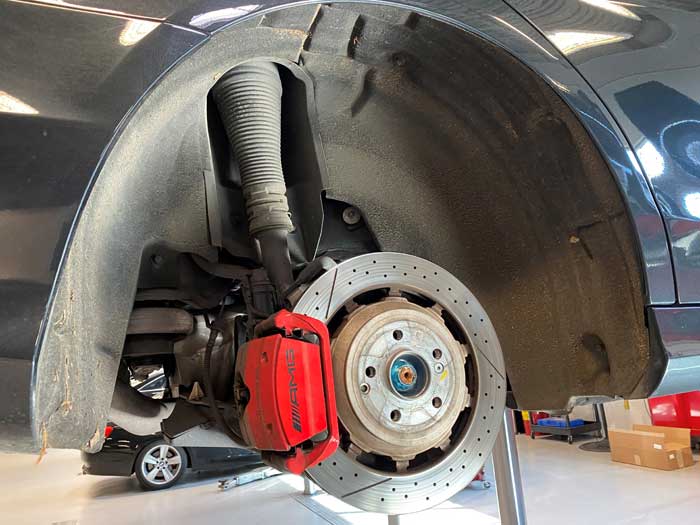At Autoscope in Dallas, we pride ourselves on providing the highest quality automotive services and parts. Understanding the critical components of your vehicle, such as the brake pads, is essential for maintaining safety and performance. In this article, we delve into the intricacies of Mercedes-Benz brake pads, offering detailed insights and practical advice to ensure your vehicle remains in optimal condition.
What Are Brake Pads and Why Are They Important?
Brake pads are a crucial part of your vehicle’s braking system. They are the components that press against the brake rotors to create the friction needed to slow down or stop your car. Given their vital role in ensuring your safety on the road, it’s important to choose high-quality brake pads and maintain them properly.
How Brake Pads Work
When you press the brake pedal, hydraulic fluid transmits force to the brake calipers. The calipers then press the brake pads against the spinning rotors, generating friction. This friction converts kinetic energy into heat, which slows down and eventually stops the vehicle.
Types of Mercedes-Benz Brake Pads
Choosing the right type of brake pad for your Mercedes-Benz is crucial for performance and longevity. Here, we outline the main types available:
1. Ceramic Brake Pads
Ceramic brake pads are known for their durability and excellent performance. They produce less dust and noise compared to other types, making them a popular choice for many Mercedes-Benz owners.
– Advantages:
– Long-lasting
– Quieter operation
– Less brake dust
– Disadvantages:
– Generally more expensive
2. Semi-Metallic Brake Pads
These pads are composed of metal fibers and other materials. They offer great performance and are often used in high-performance or heavy-duty applications.
– Advantages:
– Excellent braking performance
– Good heat dissipation
– Disadvantages:
– Can be noisier
– Produce more brake dust
3. Organic Brake Pads
Made from materials like glass, rubber, and resins, organic brake pads are often the least expensive but wear out faster.
– Advantages:
– Quieter operation
– Affordable
– Disadvantages:
– Wear out quicker
– Produce more dust
Signs Your Brake Pads Need Replacement
Regular maintenance and inspection of your brake pads are crucial. Here are common signs that indicate it’s time to replace them:
1. Squealing or Screeching Noises
A high-pitched noise often indicates that the brake pads are worn down and need replacing.
2. Grinding Sounds
Grinding noises suggest that the brake pads are completely worn out, causing the metal of the calipers to grind against the rotors.
3. Reduced Braking Performance
If your vehicle takes longer to stop or the brake pedal feels soft, it’s a sign that the brake pads may be worn out.
4. Vibration When Braking
A vibrating brake pedal can indicate warped rotors or worn-out brake pads.
How to Replace Mercedes-Benz Brake Pads
Replacing brake pads requires some mechanical knowledge and the right tools. Here’s a step-by-step guide to help you through the process:
Tools You Will Need:
– Jack and jack stands
– Lug wrench
– C-clamp
– Brake fluid
– New brake pads
– Wrench set
Step-by-Step Guide:
1. Safety First: Park your car on a flat surface and use jack stands to support it.
2. Remove the Wheel: Use a lug wrench to remove the wheel and gain access to the brake caliper.
3. Remove the Brake Caliper: Use a wrench to remove the caliper bolts and carefully slide the caliper off the rotor.
4. Replace the Old Pads: Remove the old brake pads and use a C-clamp to compress the caliper piston.
5. Install New Pads: Place the new brake pads into the caliper bracket.
6. Reassemble the Brakes: Reattach the caliper and secure it with bolts.
7. Reinstall the Wheel: Put the wheel back on and tighten the lug nuts.
8. Test the Brakes: Before driving, pump the brake pedal to ensure it feels firm.
Maintenance Tips for Prolonging Brake Pad Life
To get the most out of your Mercedes-Benz brake pads, follow these maintenance tips:
1. Regular Inspections
Check your brake pads and rotors regularly for signs of wear.
2. Smooth Driving
Avoid abrupt braking and high-speed stops to reduce wear on your brake pads.
3. Brake Fluid Check
Ensure your brake fluid is at the appropriate level and replace it as recommended by your vehicle’s manufacturer.
4. Professional Servicing
Have your brakes inspected and serviced by professionals to ensure they are in optimal condition.
Conclusion
Understanding and maintaining your Mercedes-Benz brake pads is essential for safety and vehicle performance. By choosing the right type of brake pad and following proper maintenance practices, you can ensure a smooth and safe driving experience. For more information or to schedule a brake service, contact our expert team today.
With this detailed guide, we aim to provide you with all the necessary information to keep your Mercedes-Benz brake pads in top condition. Remember, regular maintenance and timely replacements are key to ensuring the safety and performance of your vehicle.

